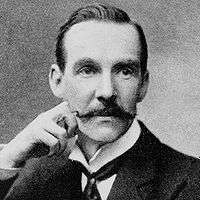E. W. Hobson
| E. W. Hobson | |
|---|---|
|
Ernest William Hobson (1856–1933) | |
| Born |
27 October 1856 Derby |
| Died | 19 April 1933 (aged 76) |
| Residence | UK |
| Nationality | British |
| Fields | Mathematician |
| Institutions | Christ's College, Cambridge |
| Alma mater |
Royal School of Mines Christ's College, Cambridge |
| Notable students |
Philippa Fawcett John Maynard Keynes |
| Known for | Real analysis |
| Notable awards |
Royal Medal (1907) De Morgan Medal (1920) |
Ernest William Hobson FRS[1] (27 October 1856 – 19 April 1933) was an English mathematician, now remembered mostly for his books, some of which broke new ground in their coverage in English of topics from mathematical analysis. He was Sadleirian Professor at the University of Cambridge from 1910 to 1931.
Life
He was born in Derby, and was educated at Derby School, the Royal School of Mines, and Christ's College, Cambridge, graduating Senior wrangler in 1878.[2] He was the brother of the economist John A. Hobson. He became a Fellow of Christ's almost immediately after graduation. He made his way into research mathematics only gradually, becoming an expert in the theory of spherical harmonics.
His 1907 work on real analysis was something of a watershed in the British mathematical tradition; and was lauded by G. H. Hardy.[3] It included material on general topology and Fourier series that was topical at the time; and included mistakes that were picked up later (for example by R. L. Moore).
From 1924 to 1927 Robert Pollock Gillespie studied under him.[4]
He is buried in the Parish of the Ascension Burial Ground in Cambridge, with his wife Seline, born 25 March 1860, died 10 June 1940, by whom he had four sons, one of whom Walter William (1894 - 1930) is buried with them in the same grave.
Works
- A Treatise on Trigonometry (1891)
- Theory of Functions of a Real Variable (1907)
- Hobson, E. W. (1921) [1907], The theory of functions of a real variable and the theory of Fourier's series. Vol. I (2nd ed.), Cambridge University Press, MR 0092828
- Hobson, E. W. (1926) [1907], The theory of functions of a real variable and the theory of Fourier's series. Vol. II (2nd ed.), Cambridge University Press, MR 0092829
- Squaring the Circle (1913)
- The Domain of Natural Science (1923) Gifford Lectures
- The Theory of Spherical and Ellipsoidal Harmonics (1931)
See also
References
- ↑ "Ernest William Hobson. 1856-1933". Obituary Notices of Fellows of the Royal Society. 1 (3): 236–413. 1934. doi:10.1098/rsbm.1934.0008.
- ↑ "Hobson, Ernest William (HB874EW)". A Cambridge Alumni Database. University of Cambridge.
- ↑ lms newsletter
- ↑ http://www-groups.dcs.st-and.ac.uk/history/Biographies/Gillespie.html
External links
| Wikiquote has quotations related to: E. W. Hobson |
- E. W. Hobson at Find a Grave
-
 Works written by or about E. W. Hobson at Wikisource
Works written by or about E. W. Hobson at Wikisource - O'Connor, John J.; Robertson, Edmund F., "E. W. Hobson", MacTutor History of Mathematics archive, University of St Andrews.
